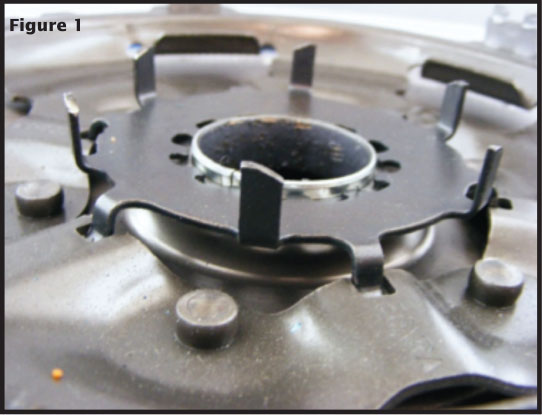
10R80 – Part 2
February 20, 2023Dodge Ram 68RFE 2019+ PI Curve Relearn
November 29, 2023A question was posted on the TCRA forum that needed a closer look. A shop was looking for rivets to re-attach the spring retainer to a late model 6F35 piston from a converter with a code C, Transtar part number FM1142 or CVC FM112. These rivets are not offered by any of the aftermarket converter parts suppliers, and they are of a non-standard size. The shop looked into modifying a 4-pound tinners rivet with a shank diameter of 0.170”-0.179” (4.32-4.55mm) and increasing the shank length from 0.345” (8.76mm) to 0.500” (12.7mm). The rivet company quoted $35.00/lb. with a 25lb. minimum. This volume and price were not an option for a small shop making 15-20 of these pistons per year.
First of all, these pistons do have an issue with extreme wear at the center bore. Sonnax offers a repair sleeve, part number FD-DS-3 (Figure 1). The piston could be fixed without removing the spring retainer by using the repair sleeve or by welding and machining the center, but there is still the problem of bonding a new lining to the piston with the spring retainer attached to the piston. By removing the retainer, it simplifies getting a proper mounting of the piston and keeping things concentric. It also makes the bonding process much simpler by removing mass, for example.
Let’s start by measuring the rivets and rivet holes in the piston and retainer. The 6 holes in the piston have an average measurement of 0.190” (4.83mm), and the spring retainer measures 0.186” (4.72mm). The work thickness of the piston and retainer is approximately 0.25” (6.35mm) with a rivet head on the piston side measuring 0.050” (1.27mm) thick and 0.285” (7.24mm) in diameter. The shop formed head measured 0.040” (1.02mm) thick and 0.320” (8.13mm), which is formed in a small recess that is 0.375” 9.53mm wide (Figure 2).
The first rivet tried, and readily available, was a Fichtel and Sachs rivet PX-12L, FS-RV-1 that measured 0.165” (4.19mm) X 0.530” (13.46mm) with a head diameter of 0.330” (8.38mm). A concern was that the 0.25” (6.35mm) shank diameter was smaller than the holes and could lead to alignment and sealing problems, but it did not work out that way. When the rivets were removed for inspection, I found the shanks had expanded into the piston completely. The only problems I could see was the shop head was not as thick as the 0.060” (1.52mm) I wanted, but the original shop head was around 0.040” (1.02mm), so I would assume this will not be an issue. The advantage of this rivet is there is no modification of parts.
The next rivet that was tried is the GM-RV-10, SX-12-16 which has a shank that is 0.193” (4.90mm) diameter and 0.5” (12.7mm) long. I thought that a rivet having a closer fit would maintain better alignment between the piston and retainer than using the Sachs rivets that had 0.025” (6.35mm) clearance. This requires drilling the holes in the piston and retainer. A #10 Drill bit was used for the piston, but the retainer is made from hardened steel and would require a carbide drill bit. A low-cost alternative is to use a 3/16” masonry bit and redress the cutting edges to an angle appropriate for cutting steel. The rivet head on these rivets are 0.090” (2.29) thick, which is 0.040” (1.02mm) thicker than the OEM rivets. The heads could be machined after installation if clearance is needed.
The last rivet tried is a 5lb. tinners rivet with a 0.181”- 0.190” (4.60-4.83mm) shank, a length of 0.375” (9.53mm), and having a 0.075” (1.91mm) thick head. The 0.375” (9.53mm) length will allow 0.125” (3.18mm) to stick out. That is minimal, but it will allow for forming a thinner shop head. As predicted, the shop head was only 0.050” (1.27mm) thick, and when the shop head was formed against the spring retainer; the rivet did not completely expand into the hole in the piston. I tried again this time installing the rivet with the shop head formed against the piston which gave much better results. There is no need to re-drill the piston with these rivets, but the holes in the spring retainer will have to be enlarged. If a thicker shop head is desired; a 3/16” X 1/2” nail head rivet, which will give a 1/4” cinch allowance; rather than the 1/8” with the 5lb. tinner rivets.
So, which of these rivets should you use? That depends on your shop’s procedures and what type of riveter you use. In this case, I would suggest buying small quantities of each and seeing what works best for your shop and procedures. One thing to remember is that rivets ranging from 0.100” (2.54mm) to 0.220” (5.59mm) generally have a tolerance on the shank diameter of + or – 0.004” (0.10mm). So, that 3/16” rivet may or may not fit a hole that is exactly 0.1875” (4.76mm).
As these short production run converters become more common; the problem of no parts being available for these converters is going to increase and also be more common. We may have to return to the 1960’s, and do a lot more fabricating of our own parts; instead of buying pre-made parts. This makes the exchanging of ideas more important than ever. The old saying “the power of a thousand minds” is more important now than it has been in the last thirty years. This is why communication and cooperation between converter shops is more important now than it has ever been.
Brad Gilbert





